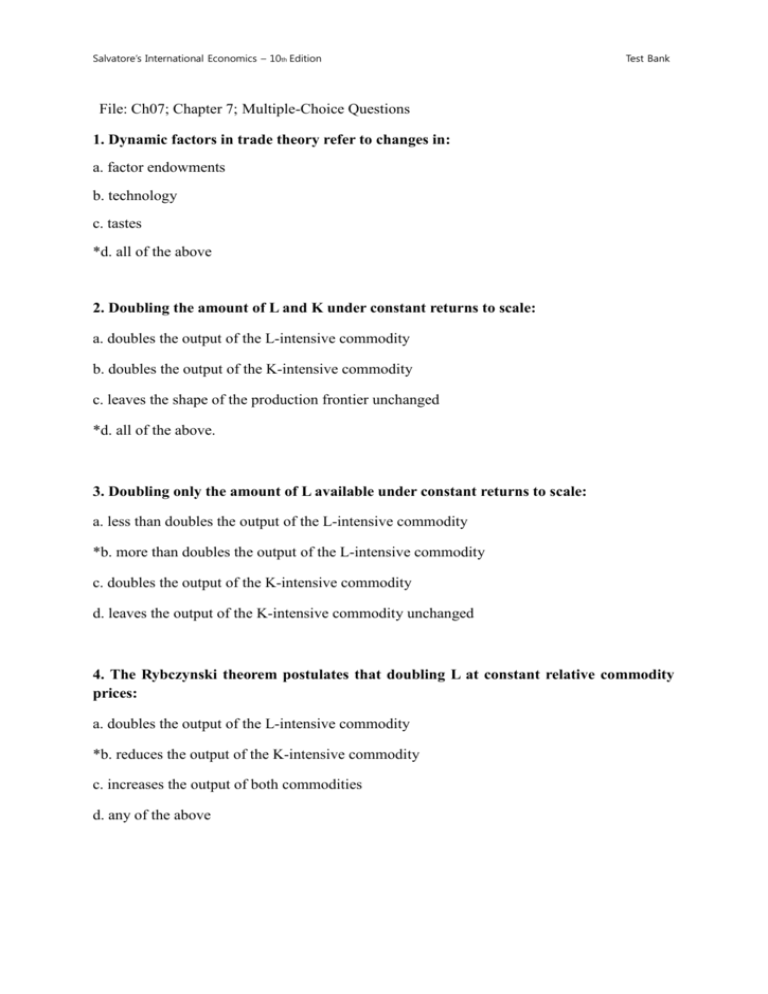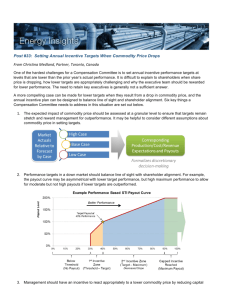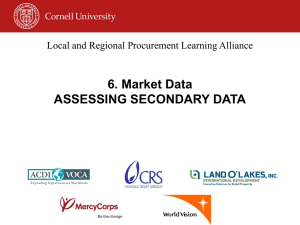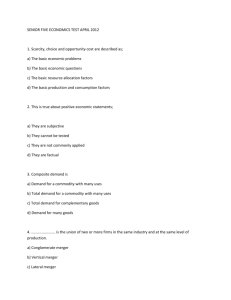Chapter 7 Test Bank
advertisement

Salvatore’s International Economics – 10th Edition Test Bank File: Ch07; Chapter 7; Multiple-Choice Questions 1. Dynamic factors in trade theory refer to changes in: a. factor endowments b. technology c. tastes *d. all of the above 2. Doubling the amount of L and K under constant returns to scale: a. doubles the output of the L-intensive commodity b. doubles the output of the K-intensive commodity c. leaves the shape of the production frontier unchanged *d. all of the above. 3. Doubling only the amount of L available under constant returns to scale: a. less than doubles the output of the L-intensive commodity *b. more than doubles the output of the L-intensive commodity c. doubles the output of the K-intensive commodity d. leaves the output of the K-intensive commodity unchanged 4. The Rybczynski theorem postulates that doubling L at constant relative commodity prices: a. doubles the output of the L-intensive commodity *b. reduces the output of the K-intensive commodity c. increases the output of both commodities d. any of the above Salvatore’s International Economics – 10th Edition Test Bank 5. Doubling L is likely to: a. increases the relative price of the L-intensive commodity b. reduces the relative price of the K-intensive commodity *c. reduces the relative price of the L-intensive commodity d. any of the above 6. Technical progress that increases the productivity of L proportionately more than the productivity of K is called: *a. capital saving b. labor saving c. neutral d. any of the above 7. A 50 percent productivity increase in the production of commodity Y: a. increases the output of commodity Y by 50 percent b. does not affect the output of X c. shifts the production frontier in the Y direction only *d. any of the above 8. Doubling L with trade in a small L-abundant nation: *a. reduces the nation's social welfare b. reduces the nation's terms of trade c. reduces the volume of trade d. all of the above Salvatore’s International Economics – 10th Edition Test Bank 9. Doubling L with trade in a large L-abundant nation: a. reduces the nation's social welfare b. reduces the nation's terms of trade c. reduces the volume of trade *d. all of the above 10. If, at unchanged terms of trade, a nation wants to trade more after growth, then the nation's terms of trade can be expected to: *a. deteriorate b. improve c. remain unchanged d. any of the above 11. A proportionately greater increase in the nation's supply of labor than of capital is likely to result in a deterioration in the nation's terms of trade if the nation exports: a. the K-intensive commodity *b. the L-intensive commodity c. either commodity d. both commodities 12. Technical progress in the nation's export commodity: *a. may reduce the nation's welfare b. will reduce the nation's welfare c. will increase the nation's welfare d. leaves the nation's welfare unchanged Salvatore’s International Economics – 10th Edition 13. Doubling K with trade in a large L-abundant nation: a. increases the nation's welfare b. improves the nation's terms of trade c. reduces the volume of trade *d. all of the above 14. An increase in tastes for the import commodity in both nations: a. reduces the volume of trade *b. increases the volume of trade c. leaves the volume of trade unchanged d. any of the above 15. An increase in tastes of the import commodity of Nation A and export in B: *a. will reduce the terms of trade of Nation A b. will increase the terms of trade of Nation A c. will reduce the terms of trade of Nation B d. any of the above Test Bank








